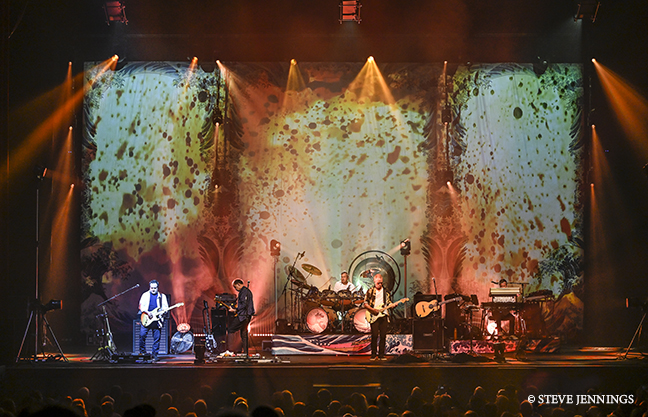
PLSN got a chance to speak with Lighting Designer Paul “PK” Kell about designing Nick Mason’s Saucerful of Secrets’ (NMSOS) Echoes Tour. The band, which formed in 2018, consists of Pink Floyd drummer and cofounder Nick Mason, guitarist/vocalist Gary Kemp, bassist/vocalist Guy Pratt, keyboardist Dom Beken and guitarist Lee Harris who perform pre Dark Side of the Moon material, bringing Floyds earlier work to the forefront.
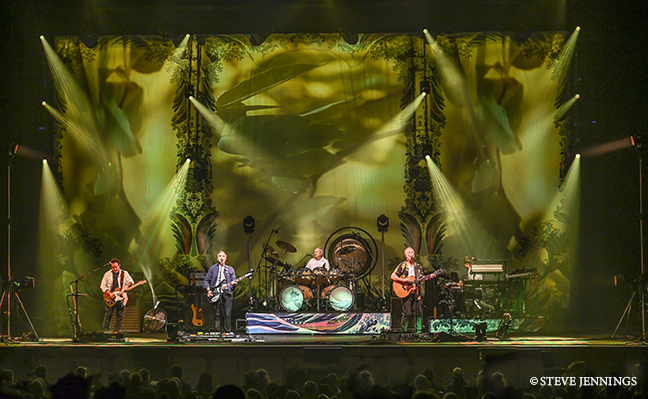
Designer Patrick Woodroffe is an old friend of Mason’s and consequently became the Executive Designer for the tour, notes PK, who has known Woodroffe since The Blues Brothers Tribute tours of the 90s. Genesis’s legendary Manager Tony Smith manages Nick Mason / NMSOS and Woodroffe has lit many tours for Smith, including Genesis and Phil Collins, as well as Smith’s international theater show Bat out of Hell. “I’d recently designed Mike And The Mechanics for (Genesis’s) Mike Rutherford and Tony Smith and I have a reputation for designing lighting rigs that will squeeze onto one truck tours, so with the first NMSOS tour in one truck, I was first in line,” comments PK. “As I tightened the nuts and bolts of both video and lighting design, Lighting Director Paul Howling locked in the video. As Manager for Genesis, Smith had invested heavily in the development of music’s first ever ubiquitous moving light, with Tony even rumored to have come up with the name ‘Vari-Lite.’ So, we had Nick Mason, Patrick Woodroffe, and Tony Smith on our shoulders, all three of them original innovators of lighting for live music… so no pressure at all there!”
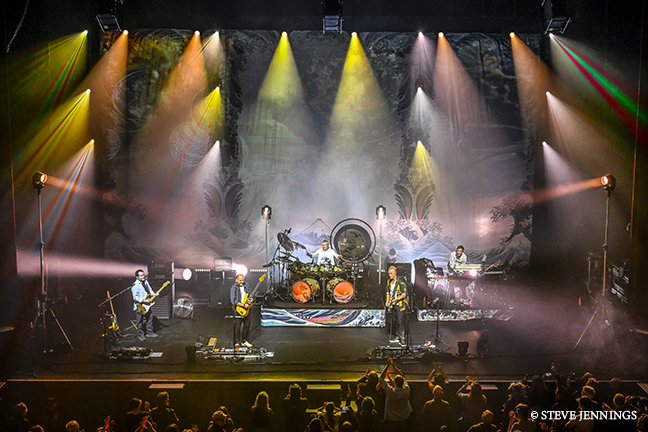
With Woodroffe busy with Adele and other projects, PK continued developing the design under Tony Smith’s watchful eye, with Nick himself always taking a keen interest in the visual impact of the show. “Nick even had a mirror fitted to his drum kit enabling him to see the projection screen during the gig,” says PK. “Musical material for NMSOS is drawn exclusively from the early Pink Floyd catalogue, featuring musical innovator and guitarist Syd Barrett, who with Nick, Richard Wright, and Roger Waters left their mark on a developing electronic music industry that would shape many generations to come. “Playing only the early Floyd material gave NMSOS a slot in the market not already filled with the wider Pink Floyd catalogue. So, it was clear from the offset this show would need a ‘retro’ feel, and we should re-visit the 60s liquid light shows which defined Pink Floyd’s early shows in Camden’s UFO Club and later at the Roundhouse. These early shows used boiling ink and old school projectors to light the first glowing embers of today’s international multimillion dollar lighting industry. These first psychedelic oil mixing light bending lighting legends included Liquid Len and the Lensmen [aka Designer Jonathan Smeeton] and Mike Leonard, once the band’s landlord. It was only then fitting that we played the Roundhouse for our London shows and DVD shoot.”
Despite lighting the first NMSOS trial pub gigs in 2017 exclusively with OPTIKINETICS’ Solar 250 projectors, venue size and consequently lighting levels had soared since those heady days of the 60s when one overhead projector could light the whole gig, notes PK. Tour Lighting Director Paul Howling set about recreating the 60s live oil techniques with internet help from a collective group, The Psychedelic Light Show Preservation Society, which includes a 60s live oil legend from across the pond—Joshua White, of the Joshua Light Show fame, and current Light Artist Steve Pavlovsky of Liquid Light Lab. “Steve showed us how to recreate oil mixes using food dyes, baby oils, alcohol, and even printer ink,” says PK. “Thanks to our Lighting Tech Mark ‘Ethnic’ Cooper, who’d himself experimented with oil shows in the 60s, we threw Alka Seltzer, iron fillings, and washing up liquid into the mix, sandwiched between oils between two glass clock-faces. Instead of school projectors, Paul now filmed his oil mixes on a digital camera above, and a light table below, beaming them via a Catalyst media server to a collection of powerful 15/20/25K laser projectors overlaid on a 12m wide screen.”
PK says Howling learned to be a master projectionist, capable of lining up two 25K projectors in broad daylight on the band’s festival run in Europe. Ironically, Catalyst itself is the brainchild of Peter Wynne-Willson [collaborating with Tony Gottelier], credited as one of Pink Floyd’s first lighting designers. “Even with a fist full of modern projection power, we had to be careful with light levels on the band who wanted a lot of light to be seen for solos, which unfortunately prevented us projecting psychedelia over them as well, as Floyd had originally done. That took care of the retro oil mixes, but we also use an array of projectors behind the band coming forward as beams to simulate a modern version of the classic Solar 250 psychedelic effect wheels fondly remembered by lighting people my age. Powerful laser projectors worked out great for this giving a us a look that lights couldn’t do to define the retro look of the show.”
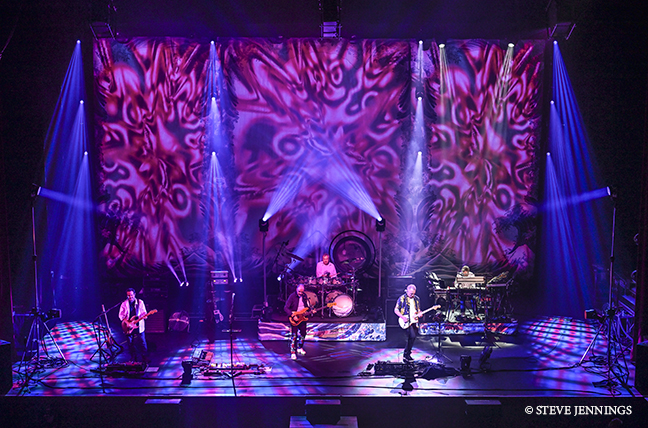
As for the actual lighting, Woodroffe’s opening gambit was 40 [Claypaky] Mythos as they were his favorite light of the time, but “I had to point out this was a truck tour with a one truck budget,” says PK. “They finally managed to fit just 12 on the truck with a spare in the bay of the bus. That being said, the 12 we had gave us the flexibility to complement the retro look we’d achieved with the projectors. For me it was Claypaky’s B-EYE K20s, later upgraded to K25s, hidden behind the backline that ‘oozed’ the psychedelia with macro effects I was after, and formed the best tool in my lighting armory. Ayrton’s oil wheel lights weren’t out then, but I was able to ‘psychedelic’ up some [Claypaky] Scenius with custom oil wheel gobos.”
PK notes how he and Howling are a tight team, with Howling regularly operating his shows. On that first tour, it was just the two of them. “Paul ran dimmers and lined up projectors while I built the rig, and for the show, Paul did live oils and operated video on one Wholehog while I operated lights on the other. We couldn’t afford to have anyone on stage. It was a little challenging to say the least. For one show on that first tour, Paul got caught backstage after a Catalyst crash, and I had to ask Tony Smith to help me to do the live oils in his place at front of house, which I must say he excelled at, injecting oils as I rotated the clock faces.”
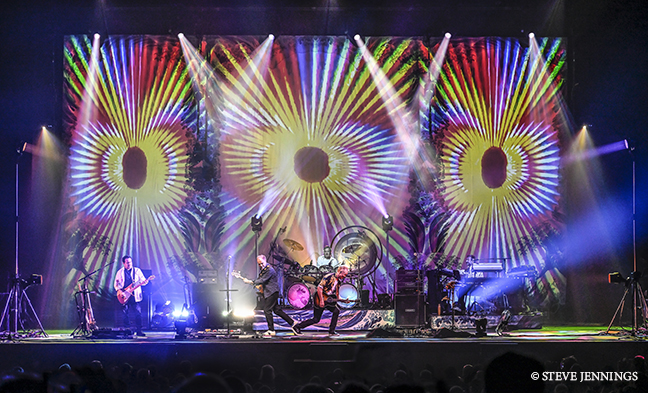
PK adds that their second oil mixer Jack Dickinson was great and feels that Rach Axton’s oil mixing tenacity upgraded the visuals to another level. “Which even oil mixing aficionado Steve Pavlovsky was impressed with when he appeared in New York for his celebrity ‘guest oil mixing’ slot. Ethnic occasionally kept his oil mixing hand in too. Hats off to Patrick Baker, our fearless Tour and Production Coordinator and Dee Miller, one of the world’s finest monitor engineers who doubled as a brilliant Stage Manager on the U.S. tour. Also, thanks to both Phil Mercer at Universal Pixels, and Neg Earth’s unfailing support throughout including shipping the entire rig to the U.S., three times.”
Production Team
- Lighting Designers: Paul “PK” Kell, Patrick Woodroffe
- Lighting Programmer: Paul “PK” Kell
- Lighting Director & Lighting Crew Chief: Paul Howling
- Lighting Techs: Mark ‘Ethnic’ Cooper, Rach Axton
- Scenic Oils: Rach Axton, Jack Dickinson
- Tour Manager: Graeme Cooper
- Production Manager: Pat Baker
- Stage Manager: Dee Miller
Production Companies
- Lighting: Neg Earth / Lindsey Markham
- Video: Universal Pixels / Phil Mercer
- Trucking: Truck’N Roll
Gear
- 2 High End Systems Hog4 Full Boar Console
- 1 SNP Productions Ltd Catalyst Media Server
- 18 Robe Robin Spikie
- 6 Claypaky Scenius Unico
- 8 Claypaky Sharpy Wash 300
- 5 Claypaky B-EYE K25 Wash
- 6 Martin MAC Aura XB Wash
- 6 Elation CHORUS LINE 16 Striplight
- 3 GLP JDC1 Strobe
- 2 Cirro Strata CS6 Hazer
- 4 hazebase Base Hazer Pro


